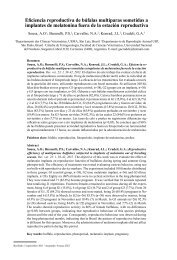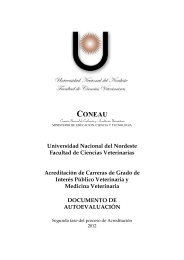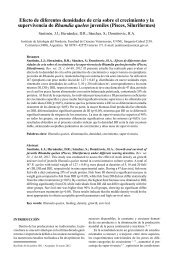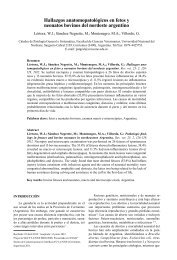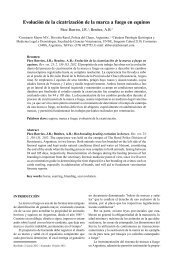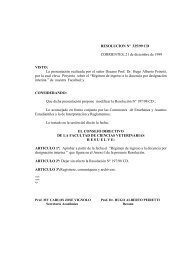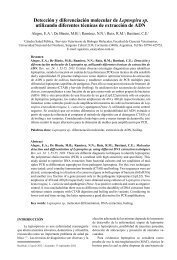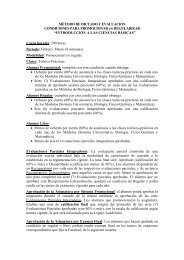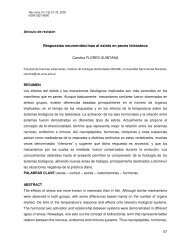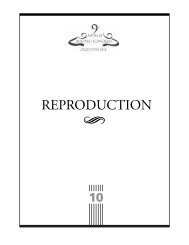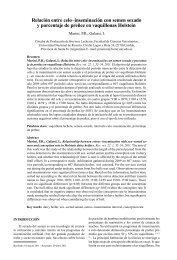MILK PRODUCTION
MILK PRODUCTION
MILK PRODUCTION
Create successful ePaper yourself
Turn your PDF publications into a flip-book with our unique Google optimized e-Paper software.
INTRODUCTION<br />
560<br />
<strong>MILK</strong> <strong>PRODUCTION</strong><br />
Buffalos have become an economically viable source of protein due to their adaptability, precocity and longevity. Human<br />
and dairy cattle interact on a daily basis in routine activities, which may have positive or negative effects on production<br />
and animal welfare 1 . Studies of animal behavior have aimed to describe how food traits and/or handling practices relate<br />
to behavioral aspects, linking behavioral changes as indicators of animal comfort with productive aspects 2 . The objective<br />
of this study was to assess the<br />
behavior of buffaloes in the milking parlor under the influence of strangers’ being present during the monthly Milk<br />
Control, throughout the first three lactation months, and verify how that affected the production of Murrah animals.<br />
MATERIAL AND METHODS<br />
Murrah buffaloes (N=24) participating in an improvement program at Recôncavo of Bahia, Brazil, were monitored during<br />
the first three months of Milk Control (CL) for their behavior in the milking parlor, in the presence of strangers.<br />
Throughout the study, there was no change in the routine followed by animals. The milking parlor is comprised of two<br />
lines with eight animals in either side. After being milked, the animals are allowed to eat for approximately one hour the<br />
concentrated mixture of wheat flour and grains, combined to suit the lactation phase.<br />
The behavioral variables monitored through direct observation were: permanence in the milking parlor (TPOR) – duration<br />
of the time the animal remained in the milking parlor, in minutes; milking time (TOR) – how long the animal was milked<br />
for, in minutes; rumination (Ru) – whether the animal ruminated in the milking parlor (equal to 1) or not (equal to 0);<br />
defecation (Def) - whether the animal defecated in the milking parlor (equal to 1) or not (equal to 0); miction (Mic) –<br />
whether the animal urinated in<br />
the milking parlor (equal to 1) or not (equal to 0); reactivity (Reat) – animal limb movements in the milking parlor (1 =<br />
remained still; 2 = limbs raised up to 15cm above the ground; 3 = limbs raised more than 15cm above the ground); stress<br />
level (Nest) – equal to 1 for a restless animal, 2 for a slightly restless animal, and 3 for a calm animal). In addition, records<br />
were made of milk production on the date (PLO), milk production one week later (PLP), and class (CAT1 for first parturition<br />
and CAT2 for multiparous). Descriptive statistics for variables TPOR (in minutes), TOR (in minutes), PLO (in kg/day)<br />
and PLP (in kg/day) were calculated by the Statistical Analysis System software (SAS,<br />
2002), as was the Spearman correlation between the production means when strangers were present in and absent from<br />
the parlor.<br />
RESULTS AND DISCUSSION<br />
The mean TPOR was 21, and the mean TOR was seven minutes. The mean PLO was 7.54 kg, whereas the mean PLP was<br />
10.06kg. Only one animal defecated and three urinated during the first CL (Figure 1). Approximately 50% presented Reat<br />
mode equal to 1, 33% equal to 2 and only 17% equal to 3, with 80% in CAT1 and 58% in CAT2 showing little or no<br />
restlessness during milking. As for the modal Nest, only two CAT2 animals were rated as restless, 40% as slightly restless<br />
and 50% as quiet. According to a previous study 1 , a high rumination rate, little reactivity during milking, reduced<br />
defecation and miction increase productivity and milk quality.<br />
Proceedings 9 th World Buffalo Congress



